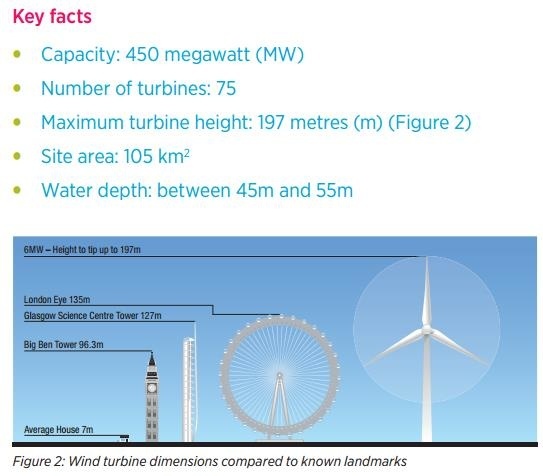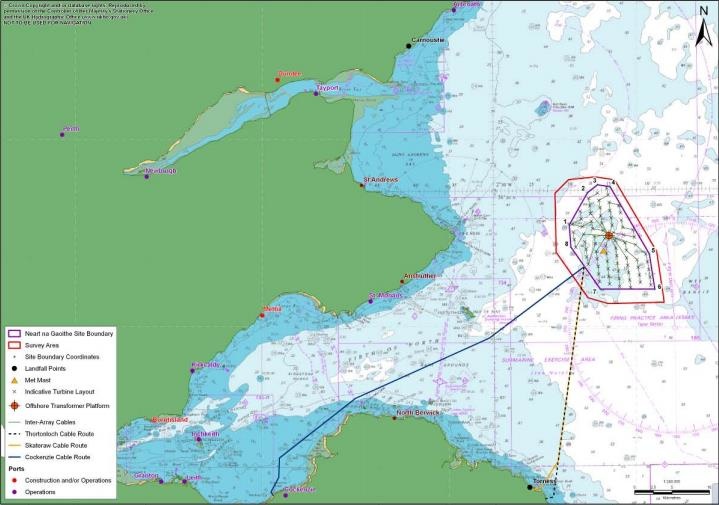News Release from windfair.net
Wind Industry Profile of
In the heart of Scottish Waters - Presenting the Neart na Gaoithe offshore wind farm
About Neart na Gaoithe
The proposed Neart na Gaoithe offshore wind farm is located some 15km off the Fife coast and covers an area of approximately 100km2. Mainstream was awarded the site in February 2009 by the Crown Estate as part of a competitive bidding process. The project has the potential to generate 450MW of renewable energy, which is enough power to supply around 325,000 Scottish homes - more than the whole of Edinburgh. It will offset over 400,000 tonnes of CO2 emissions each year, as well as making a significant contribution towards the delivery of the UK's share of the European Union target of 20% renewable energy by 2020.
Mainstream's aim is to develop an environmentally and socially responsible project that is viable to construct and operate. Mainstream is committed to the principle of local economic development and actively welcomes inquiries from Scottish businesses who are interested in contributing to the success of Neart na Gaoithe.

The Neart na Gaoithe site was chosen because it combines technical, economic and environmental deliverability. Criteria which formed part of the site selection process included:
- water depth,
- ground conditions,
- expected energy yield,
- met-ocean conditions,
- proximity to grid lines,
- nearby port facilities as well as
- assessment of potential human, biological and physical environmental sensitivities.
Subject to securing the necessary consents, it is expected that the wind farm will commence construction by 2015. Connection to the National Grid will be made at Crystal Rig wind farm in Lammermuir Hills, East Lothian. It is anticipated that onshore construction will start in 2015, with fi rst generation expected in 2017.
A map of the proposed project is shown below, alongside the coordinates of the site boundary:

Development process and milestones
As Neart na Gaoithe is a fairly new project Windfair has decided to follow its progress as it develops
The following excerpt provides an overview of the process involved in the development of an offshore wind farm.
More information on each stage is below.

Surveys
Surveys will be undertaken at site to obtain suitable and sufficient data to assess the sensitivity of the environment within and surrounding the site. Surveys will include a geophysical survey to broadly characterise the area, which will require a specialist vessel to visit and traverse the offshore site, followed, later in the year, by more detailed seabed surveys where sediment samples will be taken.
The longest running surveys are those for birds and marine mammals, involving experienced surveyors who will record birds and marine mammals using the Neart Na Gaoithe site so that an assessment of the importance for the area for birds and marine mammals can be undertaken.
Bird and marine mammal data from two years of surveys is typically required in order to apply for consent.
These surveys and other works will enable environmental experts to assess potential impacts of the proposed wind farm with regards to the local environment and in the context of wider ecosystems. The first surveys to be undertaken by Mainstream will be the geophysical surveys that provide precise measurements of water depth and the character of seabed through non-intrusive means. Not only does this data allow for preliminary design studies to be undertaken and areas unsuitable for construction to be identified, it also allows biologists to identify potential areas of environmental significance such asreef habitats, likely spawning areas for fish and feeding grounds for birds or marine mammals. Additional information can be gained about areas of interest by means of "grab" sampling, whereby a device is used to scoop up samples of the seabed for analysis of the benthos (the organisms which live on, in, or near the seabed).
Bird and marine mammal surveys will be tailored using the depth and seabed type information from the geophysical survey. The surveys will confirm the degree that bird and mammals actually visit the proposed wind farm location, indicating the level of sensitivity to construction and operating Neart na Gaoithe. Surveys will also allow data to be collected on the behaviour of the various species of birds and mammals that use the site and its surrounding area such as whether they are feeding or traversing the site. This helps with assessing the significance of any potential impacts on birds and marine mammals. Mainstream is also considering undertaking acoustical surveys of the site as well as radar studies to provide further information on birds and marine mammals.
At a later stage, geotechnical surveys will be undertaken on the site. These intrusive surveys involve pushing a cone or drilling into the seabed to determine how firm it is and what materials it is made of. Samples of the seabed are taken an analysed for stiffness and suitability for construction. Surveys of fishing and shipping traffic are also expected to be undertaken.
Surveys will be undertaken along an export cable route and onshore at the site of a substation. These will take note not only of the natural environment in these areas but also of human activities. Visual impacts will be carried out to determine how visible various elements of the wind farm and its ancillary works are and what potential mitigations could be implemented to reduce their visibility.

Met Mast Installation
Once geophysical surveys, and preliminary geotechnical surveys, are completed met mast (meteorological mast) design will be possible. Placement of the met mast will likely be on the upwind, western side, of the site which is closest to shore. The met mast will have many instruments on it, chief among which will be anemometers at various heights which will indicate how strongly and often the wind blows on the site. From this data the wind resource can be calculated, and once the layout of the site is designed, how much energy can be generated per year. The mast will likely be tens of metres high, positioned on top of a monopile foundation. Further specifications will be available once a more detailed design study has been completed.

EIA
An Environmental Impact Assessment (EIA) assesses the likely impacts of a project based on project design and analysis of data collected from surveys and research. The EIA will be integrated into the Mainstream project processes and completed by expert consultants experienced in offshore EIAs. Depending on preliminary results and guidance the project designs may be altered to alleviate risks identified in the EIA, prior to a consent application being submitted. Stakeholders and independent experts will be involved in the EIA process as much as practicable in order to ensure that its conclusions are acceptable and of the highest possible quality.
Once the EIA has been completed an Environmental Statement (ES) is drafted to summarise the EIA's methods and findings. This ES is then submitted with an application for consent of the project. At the same time the ES and a non-technical summary is made publically available and all stakeholders are made aware of it. The regulatory body, Scottish Government, is then responsible for conferring with statutory stakeholders and local bodies and reaching a decision as to whether the environmental impacts associated with the proposed project are acceptable and therefore the project is able to proceed. If a positive decision is reached, conditions may be placed on the consent such as a requirement to continue monitoring potential impacts on biological, physical or other aspects of the environment.

Design
The design process for an offshore windfarm is iterative, the final turbine layout, substation location and other key parameters will evolve throughout the development lifecycle in response to environmental and technical constraints which arise. The final desing will include the layout of the site, indicating the location and size of the turbines design of turbine and substation foundations, inter-array and export cable routes, and the design of onshore infrastructure. All Design work will feed into the planning process such that any consents granted will allow for a quick transition into the construction phase and to ensure the EIA has assessed all potential impacts of the proposed wind farm. Design work will also include consideration of transport of equipment and personnel to the project during construction and operations, as well as other logistics.
During the design stage, prior to consent, it is likely that procurement will commence. This is due to long equipment lead times and the requirement to put forward deposits on turbines and electrical equipment. It is hoped that increase supply capacity will reduce lead times and deposit sizes such that the commencement of procurement will coincide more closely with achievement of consent.

Award of Consent
Upon award of consent work will begin in earnest to prepare the project for construction. This will include finalising any still outstanding design decisions, completing the negotiation of procurement contracts, and lining up project financing. Most importantly, however, will being ensuring that any conditions placed on the consent of the project are promptly and completely fulfilled.
It is the intention of Mainstream that our project is the first to be consented and constructed of those awarded inside 12 nautical miles in Scotland. In this way we will be doing our part to enable the UK to undertake its necessary step change from fossil fuel and CO2 dependence to a green renewable future, and to help position Scotland at the forefront of the offshore windfarm supply chain.
Electrical Transmission System
The turbines will be located over 35km from the grid connection point at Crystal Rig in East Lothian and will be connected via buried High Voltage Alternating Current (HVAC) cables both offshore and onshore.
The Figure below shows the key components of an HVAC transmission system. Within the wind farm, a number of ’inter-array’ cables will connect the turbines to an offshore substation. ‘Export cables’ will be located between the offshore substation and the landfall at Thorntonloch Beach in East Lothian. Close to the landfall, the export cables will connect to onshore cables which will be buried between the coast and a new substation, located adjacent to an existing substation at Crystal Rig onshore wind farm.

To receive more information on this article, our Newsletter or find out more about what w3.windfair.net has to offer, please, do not hesitate to contact Trevor Sievert at ts@windfair.net.
Please don't forget to follow us on Twitter: w3.windfair.net on Twitter
w3.windfair.net is the largest international B2B internet platform in wind energy – ultimately designed for connecting wind energy enthusiasts and companies across the globe.
- Source:
- Mainstream Renewable Power
- Author:
- Trevor Sievert, Online Editorial Journalist / By MRP Staff /
- Email:
- ts@windfair.net
- Link:
- www.windfair.net/...

